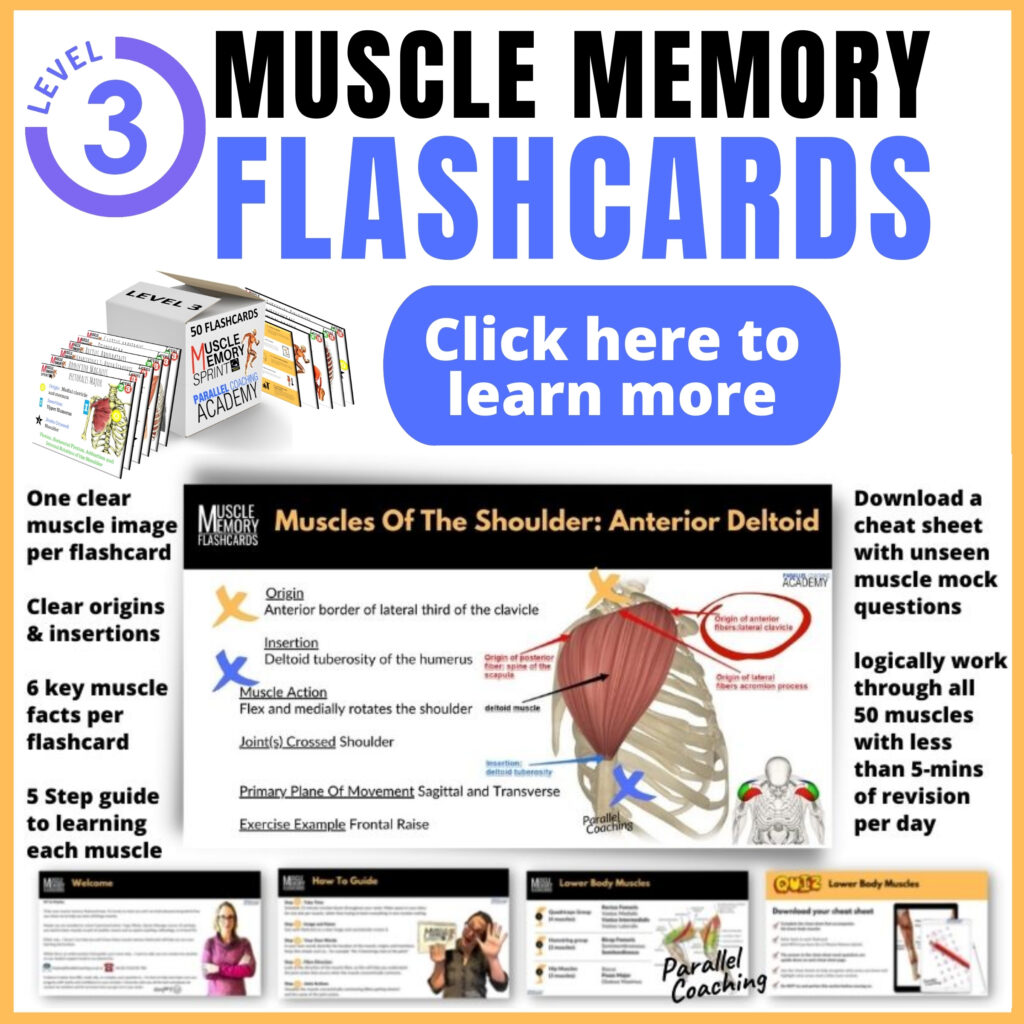In today’s video training, you’ll learn how to remember the muscle Origin and Insertions of the Deltoids muscle group, ready for your Level 2 or Level 3 Anatomy and Physiology Exam.
I’ll show you exactly how to remember complex information about the Deltoid, including the origin and insertion, location, muscle action, and exercises that work the muscle. This means that you use a mix of visual and kinaesthetic learning to commit the facts to your memory and forge out a new neural pathway.
You can then use this same method of learning for all of the other muscles you need to learn for your Level 2 and Level 3 anatomy and physiology exam.
First of all, watch the 20-minute video tutorial and then test your knowledge using the three mock questions at the bottom of this blog.
Watch: Origin and Insertion of The Deltoids
Where is the Deltoid?
The deltoid is a large, triangular muscle covering the shoulder joint.
It consists of three distinct parts: the anterior (front), medial (side), and posterior (back) deltoids.
You need to know key information about the Deltoid for your exam, including the location, origin and insertion, muscle action, and example exercises.
What is the Origin and Insertion of The Deltoids Muscle Group?
Although the Insertion point is the same for all three Deltoid Muscles, each has a different Origin. This means that the three muscles create very different actions.
- Insertion of all three: Deltoid tuberosity of the humerus.
- Origin of Anterior Deltoid: Lateral third of the clavicle
- Origin of Medial Deltoid: acromion process
- Origin of Posterior Deltoid: spine of the scapula
What is the Muscle Action of the Deltoid?
The deltoid is responsible for several movements of the shoulder joint. It primarily functions to move the arm in various directions, and its different fibers contribute to different actions:
- Anterior Fibers: Flexion and medial rotation of the shoulder.
- Lateral Fibers: Abduction of the shoulder.
- Posterior Fibers: Extension and lateral rotation of the shoulder.
When the deltoid muscle contracts, it brings the insertion (deltoid tuberosity of the humerus) towards the origin (lateral third of the clavicle, acromion, and spine of the scapula).
Exercises that work the Deltoid include:
- Shoulder Press
- Lateral Raise
- Front Raise
- Reverse Fly
- Arnold Press
- Upright Row
In this video, we follow 5 simple steps to help you Remember Muscle Origins and Insertions
This 5-step strategy will simplify and structure how you are learning the key muscle information. This is not only great for your exam but also when planning and working with clients.
Step 1: Take Time
Schedule 15-minute chunks spread throughout your week. Make space in your diary for one slot per muscle, rather than trying to learn everything in one revision sitting.
Step 2: Image and Name
Use a clear image, like those in our L2/3 Flashcards, of the muscle you are learning. Ensure the name is clearly printed on the image to make it easy to commit to your visual memory.
Look at the image and close your eyes to see if you can remember the image and name together.
Here’s an example of the Deltoid from our Muscle Memory Sprint Flashcards:
Step 3: Your Own Words
In your own words, describe the location of the muscle and its origins and insertions.
So for the deltoid, I might say: “It’s the muscle covering the shoulder. It originates from the lateral clavicle, acromion, and spine of the scapula, and inserts on the deltoid tuberosity of the humerus.”
Then double-check the “official” terminology of the origin and insertion so you know for sure.
Step 4: Fibre Direction
Look at the direction of the muscle fibers, as this will help you understand the joint action that occurs when the muscle concentrically contracts.
So as the muscle shortens, you can imagine the insertion being drawn closer to the origin.
Step 5: Joint Actions
Visualize the muscle concentrically contracting (fibers getting shorter) and the name of the joint action.
In my example, this would be flexion, abduction, extension, and rotation of the shoulder.
Then pick an exercise that works this muscle. For example, to target the deltoid, I could choose the Shoulder Press.
By repeatedly doing this exercise, you can feel the muscle contracting and relaxing, which helps you to commit it to memory.
Test your knowledge with 3 Mock Questions
Look at the Muscle Anatomy and Physiology Mock questions below and jot down your answer on scrap paper or as a note on your phone.
Then scroll down to reveal the answers.
1.What action occurs when the anterior fibres of the deltoid concentrically contract?
- A. Abduction of the arm
- B. Flexion of the arm
- C. Extension of the arm
- D. Lateral rotation of the arm
2. What is the insertion of the posterior deltoid muscle?
- A. Lateral third of the clavicle
- B. Acromion
- C. Spine of the scapula
- D. Deltoid tuberosity of the humerus
3.Which exercise does NOT work the deltoid muscle?
- A. Shoulder Press
- B. Lateral Raise
- C. Bicep Curl
- D. Front Raise
Answers:
Q1: Answer = B
Q2: Answer = D
Q3: Answer = C
If you want more mock questions like this, then you can download more Free Mock Questions: DOWNLOAD NOW
How to learn origins and insertions?
Learn, Revise & Remember All 50 Muscles In The Level 3 Anatomy & Physiology Exam.
(and the BEST part…You can do all this in as little as 5-minutes a day)
Each flashcard gives you a clear image and six clear muscle facts:
- Name and Location
- Origin and Insertions
- Muscle Actions
- Joints Crossed
- Primary Planes Of Movement
- Exercise Examples

Dedicated to More
Hayley “Origin and Insertions of the Deltoids” Bergman
Parallel Coaching
P.S. You can also find us on the following platforms:
Instagram: Follow Now
Facebook: Like Our Page
Twitter: Tweet Us
YouTube: Subscribe Here
More Muscle Revision Blogs: HERE

